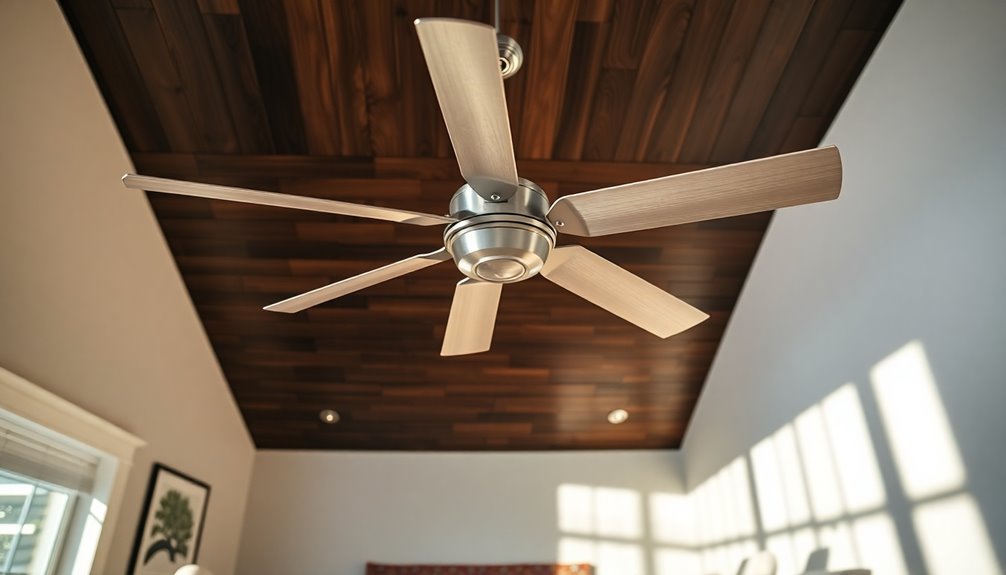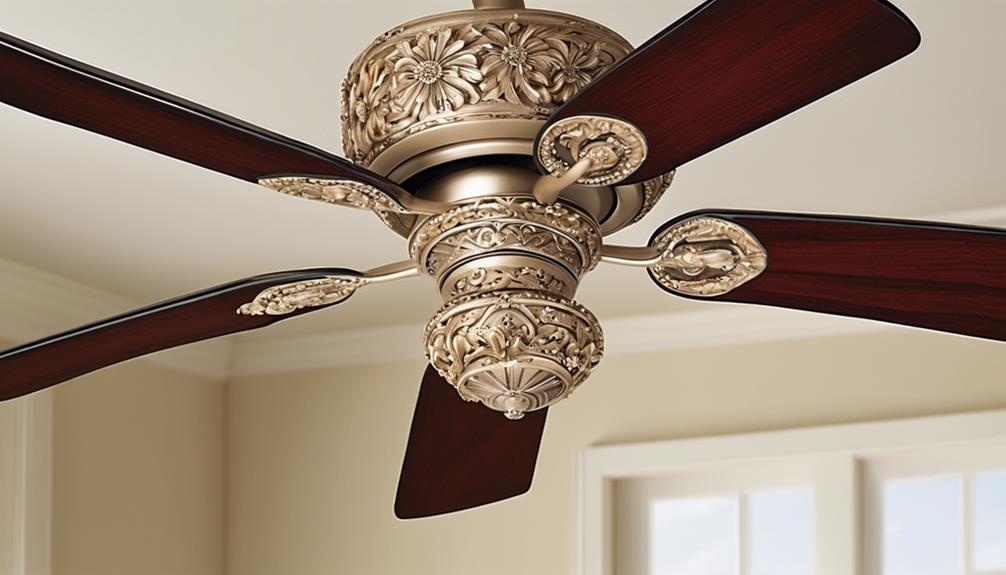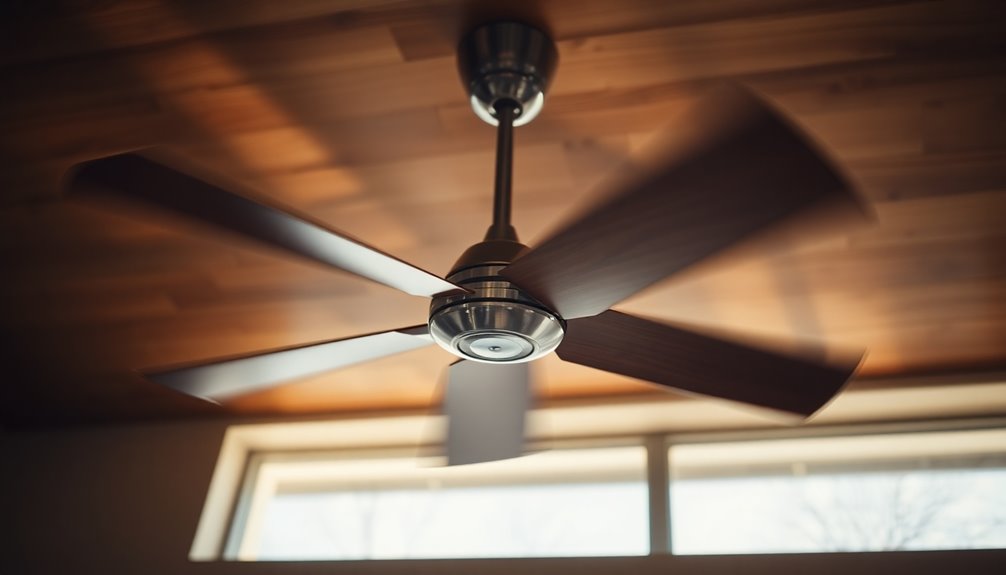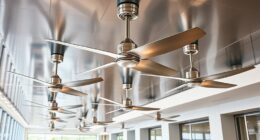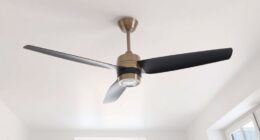Ceiling fans rarely fall when installed correctly, but improper installation can increase risks. Statistics show fewer than seven fatalities annually due to ceiling fan incidents in the U.S., but injuries do occur, especially in high-traffic areas. Core issues like loose screws or weak brackets can compromise stability. Regular maintenance, such as inspecting components and confirming secure installation, is essential. Fans should be at least seven feet above the floor for added safety. By keeping an eye on these factors, you can guarantee your fan stays securely in place. Want to uncover more tips to keep your ceiling fan safe?
Key Takeaways
- Ceiling fan-related deaths average fewer than 7 annually in the U.S., indicating their overall safety when properly installed.
- From 2005 to 2010, 136 children were treated for ceiling fan injuries, highlighting the importance of safety measures.
- A Townsville study noted 50 hospital visits for ceiling fan injuries, though severe incidents are rare with proper installation.
- Improper installation is the primary cause of ceiling fan falls, emphasizing the need for secure mounting and regular maintenance.
- Regular inspections and maintenance can prevent wobbling and potential falls, ensuring the fan's stability and safety.
Ceiling Fan Fall Statistics

When it comes to ceiling fan safety, the statistics reveal a reassuring trend. On average, fewer than seven ceiling fan-related deaths occur each year in the United States, suggesting that fatal incidents are rare. However, you should remain aware of the potential risks, especially concerning improper installation.
From 2005 to 2010, 136 children were treated for injuries related to ceiling fans, highlighting the importance of ensuring fans are securely mounted and out of reach.
In Townsville, a study recorded 50 hospital visits due to ceiling fan-related injuries between 1995 and 1997. While severe injuries from falling ceiling fans are uncommon, caution is still necessary, particularly in homes with children or low ceiling clearance.
Ceiling fans generally fall vertically when they detach, with improper installation being the main culprit. This emphasizes the need for proper installation practices to minimize the risk of a ceiling fan fall.
Causes of Ceiling Fan Falls

When it comes to ceiling fan falls, improper installation techniques are a major culprit.
If you don't secure the fan properly or use the right junction box, you're setting yourself up for trouble.
Worn-out components can also weaken the fan's stability, making regular maintenance essential for safety.
Improper Installation Techniques
Improper installation techniques are a leading cause of ceiling fan falls that can pose serious safety risks. If you don't use a junction box rated for ceiling fan support, you're increasing the chances of your installed ceiling fan falling.
It's essential to guarantee that mounting screws are fastened securely to solid wooden joists; inadequate fastening creates instability and makes the fan prone to detachment.
Additionally, neglecting to inspect the integrity of the mounting bracket or canopy can hide vulnerabilities that may lead to unexpected falls.
In older homes, fans installed without additional support are particularly at risk due to outdated installation methods.
You should always check for proper clearance and alignment according to the manufacturer's guidelines.
Worn-Out Components
Ceiling fans can also fall due to worn-out components that compromise their stability. Over time, parts like frayed wires or deteriorated mounting brackets can greatly weaken a fan's structural integrity, increasing the risk of falls.
Regular inspections are essential to catch issues before they escalate. Here's what you should check:
- Wires: Look for frayed or damaged wires that can cause electrical hazards and instability.
- Mounting Brackets: Verify brackets are secure and free from rust or corrosion, as deterioration can lead to detachment.
- Screws: Tighten any loose screws, as they can contribute to fan wobbles and eventual failure.
- Fan Blades: Inspect blades for chips or cracks, which can affect balance and stability.
Risks Associated With Falling Fans

Although the risk of a ceiling fan falling is relatively low with proper installation, it's important to recognize the potential dangers associated with falling fans.
While fewer than seven ceiling fan-related deaths occur annually in the U.S., injuries can still happen. If your fan isn't installed correctly, loose screws or weak mounting brackets can heighten these risks, allowing the fan to detach unexpectedly.
When fans do fall, they typically go straight down, but improper installation may lead to non-vertical falls, causing additional hazards for anyone nearby. This unpredictability can result in serious injuries, especially in high-traffic areas.
Regular maintenance and inspections are essential to mitigate these risks, as continuous movement can loosen mountings over time.
Older or decorative models may be more prone to these issues, so routine safety checks are necessary to guarantee they remain securely installed.
By staying proactive with maintenance, you can greatly reduce the likelihood of accidents and keep your living space safer.
Preventing Ceiling Fan Falls

To keep your living space safe from the dangers of falling fans, focus on proper installation and regular maintenance. A well-installed ceiling fan greatly reduces the risk of accidents, while routine checks guarantee its stability.
Here are some key steps you should take:
- Use a fan brace: Confirm the ceiling fan is mounted on a junction box rated for fan support to provide a strong foundation.
- Inspect regularly: Check mounting brackets and screws to identify any loose components that could lead to a wobbly fan or potential falls.
- Height matters: Install fans at least 7 feet above the floor, especially in high-traffic areas, to minimize the chances of accidents.
- Add safety cables: For heavier fans, using safety cables offers an additional layer of security in case of mounting failure.
Importance of Proper Installation

Proper installation of ceiling fans is vital; it directly impacts safety and functionality in your home. If you don't mount your fan correctly, you increase the risk of it falling, which can cause serious injuries or damage. Always make certain you use junction boxes rated for ceiling fan support. These boxes are designed to handle the weight and movement of the fan, providing a secure foundation.
Fastening mounting screws to solid wooden joists greatly enhances the fan's stability. This step reduces the likelihood of the fan detaching, making sure it operates safely and effectively.
Regular inspections of your fan's installation are important as well. By checking for loose screws or improper support, you can catch issues before they become dangerous.
While some may attempt DIY installation, it's often best to hire a professional. They'll verify your installation complies with current safety standards, minimizing the risk of accidents. Additionally, ensuring that the fan is mounted properly can help prevent issues related to heat pump efficiency such as vibrations that may occur from inadequate support.
Maintenance Tips for Ceiling Fans

Regular maintenance of your ceiling fan is essential to keep it running smoothly and safely. By following these maintenance tips, you can guarantee your fan operates at its best and prevent any potential issues.
- Inspect Mounting Bracket: Every six months, check the mounting bracket and screws for tightness. Loose fittings can cause wobbling, creating safety hazards.
- Clean Fan Blades: Dust accumulation can affect balance and performance. Wipe down the blades regularly to maintain efficiency.
- Check for Damage: Look for signs of wear or damage, such as bent blades or loose wiring. Address any issues promptly to guarantee safe operation.
- Professional Help: Consider hiring a licensed electrician for a thorough inspection. They'll guarantee everything complies with safety standards, providing peace of mind.
Signs of a Potential Fall

If your ceiling fan starts wobbling or making unusual noises, it's time to take a closer look.
These signs often indicate loose mounting components or misaligned blades that could lead to a fall.
Regularly checking for these issues can help keep your fan securely in place.
Wobbling and Noise Indicators
Wobbling and noise from your ceiling fan can be alarming, signaling potential issues that shouldn't be ignored.
These irregularities often indicate problems like blade misalignment, loose screws, or pressure imbalances on the blades. If left unaddressed, continuous wobbling can escalate, increasing the risk of your fan detaching from the ceiling.
Here are some signs to watch for:
- Visible Wobbling – If you notice your fan swaying excessively, it's time to inspect it.
- Unusual Noises – Grinding or rattling sounds can indicate loose components that need attention.
- Loose Screws – Check for any screws that feel loose; tightening them can improve stability.
- Blade Misalignment – Verify all blades are level; misalignment can cause uneven pressure and further wobbling.
While wobbling doesn't guarantee that your fan will fall, it can lead to complications, like the detachment of minor components.
Regular inspections can help you identify these issues before they become serious safety hazards, so don't wait—take action as soon as you notice any irregularities.
Loose Mounting Components
Excessive wobbling often points to deeper issues, particularly related to loose mounting components. If your ceiling fan is shaking or rattling, it's essential to address these signs immediately.
Loose mounting components, such as screws or brackets, can greatly increase the risk of the fan detaching from its fixture, leading to potential falls.
You should conduct regular inspections every six months to verify the integrity of your ceiling fan's mounting components. Check for loose screws in the mounting bracket and canopy.
If you notice any instability, it's important to tighten these components before continuing to use the fan. Ignoring these signs can lead to dangerous situations, not just for the fan but for anyone underneath it.
A properly installed ceiling fan should remain stable and secure. By proactively checking for loose mounting components, you can maintain safety and functionality in your home.
Don't wait for accidents to happen; take action when you notice excessive wobbling. Confirming your ceiling fan is firmly attached can prevent costly repairs and, more importantly, protect you and your loved ones from harm.
What to Do If Your Fan Wobbles

A wobbly ceiling fan can be a source of frustration and distraction in your home.
Fortunately, there are steps you can take to address this issue. Follow these simple actions to restore balance to your fan:
- Stop the Fan: Always verify the fan is completely stopped before attempting any adjustments.
- Tighten Screws: Check and tighten the mounting screws and the screws that connect the fan blades to the fan hub. Loose screws are often the culprit behind wobbling.
- Inspect the Blades: Look for any bent fan blades. If you find any, consider replacing them to restore proper balance and function.
- Regular Maintenance: Conduct a thorough inspection of your fan every six months. Clean dust off the blades and verify that all components are secure to prevent future wobbling.
When to Hire a Professional

When should you consider bringing in a professional for your ceiling fan issues? If you notice persistent wobbling or instability in your indoor ceiling fans, it's time to call a professional electrician. They can assess the installation and correct any underlying issues to guarantee your fan operates safely.
If you suspect your ceiling fan was improperly installed or you're unsure about its mounting safety, hiring a professional is a smart move. They'll assure everything meets current installation standards.
Regular maintenance checks, recommended every six months, can also help prevent potential safety hazards associated with ceiling fans.
For complex installations, especially those involving multiple fans or high ceilings, it's best to rely on a professional's expertise. They can ascertain a safe and effective setup.
Additionally, if you experience electrical issues—like flickering lights or unusual noises from your fan—consulting a licensed electrician can help you avoid potential accidents or failures.
Frequently Asked Questions
What Are the Odds of a Ceiling Fan Falling?
When it comes to ceiling fans, the odds of one falling are quite low, especially if it's installed correctly.
Most incidents occur due to improper installation rather than wobbling. If you notice your fan wobbling, it's a good idea to check for misaligned blades or secure mounting.
Regular maintenance and inspections can help catch any potential issues early.
How Easy Is It for a Ceiling Fan to Fall?
Did you know that less than seven ceiling fan-related deaths happen annually in the U.S.? It shows how essential proper installation is.
A ceiling fan's likelihood of falling hinges on how securely it's mounted. If you've not tightened the screws or used an adequate junction box, you're increasing the risk.
Regularly checking your fan's stability can help you avoid accidents, ensuring it stays safely overhead without wobbling or detaching.
Can a Wobbly Ceiling Fan Possibly Fall?
Yes, a wobbly ceiling fan can potentially fall, but it's rare if it's properly installed.
Wobbling usually indicates issues like loose screws or bent blades, which mightn't directly lead to a fall.
Regular maintenance checks can help you identify and fix these problems before they escalate.
How Safe Are Ceiling Fans?
They say, "A stitch in time saves nine," and that definitely applies to ceiling fans.
When properly installed and maintained, ceiling fans are quite safe. By ensuring they're securely mounted to solid joists and keeping up with regular inspections, you can greatly reduce the risk of accidents.
Remember to install your fan at the recommended height of 2.1 meters to keep children and pets safe.
With a little care, your ceiling fan can be a reliable fixture.
Conclusion
To summarize, while ceiling fan falls are rare, they can pose serious risks if not properly managed. By keeping an eye on installation, maintenance, and any signs of trouble, you can guarantee your fan stays put. Remember, it's better to be safe than sorry—don't wait until it's too late to address issues. If you notice any wobbling or instability, reach out to a professional. Keeping your home safe is always worth the extra effort!



